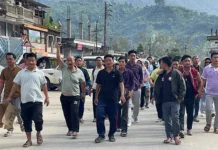[Badak Yomgam]
The recent Sustainable Development Goals-12 include focusing on responsible consumption and production, especially in tourism, which is paramount for fostering sustainable rural tourism in Arunachal Pradesh. This objective calls for a comprehensive approach that minimizes the environmental footprints of tourism activities and cultivates sustainable practices throughout the entire tourism value chain, benefitting both the environment and local communities.
Achieving responsible consumption and production in Arunachal’s rural tourism requires a significant focus on minimizing the environmental impact. This encompasses robust waste management strategies, particularly vital in remote areas, which must include efficient systems for segregation, recycling and composting. Education for both tourists and locals on proper waste disposal is also important. Additionally, promoting water and energy efficiency is key: this means encouraging practices like rainwater harvesting, installing water-efficient fixtures and increasing the reliance on renewable energy sources, such as solar power, for homestays and other tourism infrastructure.
Sustainable sourcing also plays a crucial role by advocating the use of locally sourced, eco-friendly building materials for any new constructions or renovations and promoting local organic produce for food, thereby reducing transportation-related carbon footprints and strengthening regional economies.
Integrating sustainable practices across the entire tourism value chain is essential. Tour operators are encouraged to design itineraries that actively minimize environmental impact, respect local cultures, and ensure fair wages and equitable treatment for local guides. Tourists are also required to be educated on responsible behaviour during their visit.
Homestays, a distinctive and growing segment of rural tourism in Arunachal, should be actively supported in adopting sustainable practices, such as effective waste reduction, energy conservation and sourcing food from local producers. Crucially, empowering local communities to be active participants in tourism planning and management ensures that their invaluable traditional knowledge and existing sustainable practices are integrated into all tourism operations, particularly concerning natural resource use and conservation.
A fundamental component of responsible consumption involves educating both visitors and local populations. This includes launching effective awareness campaigns to inform tourists about responsible travel practices such as minimizing plastic use, showing respect for local customs and traditions and actively supporting local businesses. Promoting the purchase of authentic, locally-made handicrafts and products, especially those made from sustainably sourced materials, is encouraged as it directly supports local artisans and economies while discouraging mass-produced or unsustainable products.
Moreover, responsible tourism dictates that cultural performances, rituals and traditional practices are presented authentically and respectfully, avoiding any form of commodification or degradation, and tourists are educated on the significance of these local traditions.
Optimizing the use of natural resources is non-negotiable for sustainable rural tourism in Arunachal, a region renowned for its rich biodiversity. Tourism activities must be meticulously planned to ensure they do not negatively impact local ecosystems, including the unique flora and fauna. This involves practices like establishing nature trails that cause minimal disturbance, strictly enforcing rules against littering, and promoting wildlife viewing without interference or disruption to natural habitats.
Furthermore, it is paramount to prevent uncontrolled development of tourism infrastructure that could encroach upon valuable forests, agricultural land or other sensitive ecological zones. Sustainable land use planning is therefore essential to safeguard the pristine natural beauty and vital resources that draw tourists to the region, ensuring their preservation for future generations. (The contributor is a PhD scholar at NEHU, Shillong)



